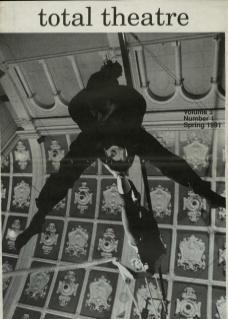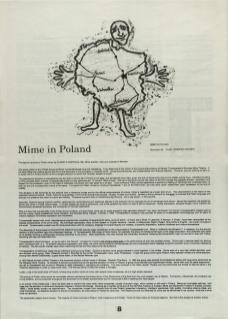The grand notion of the ‘Polish School of Mime’ is simultaneously true and misleading. Truly deserving of this notion is the unique phenomenon of Henryk Tomaszewski's Wroclaw Mime Theatre. In the early fifties his creative genius led him to the discovery of the principles of classical mime – almost simultaneously with, yet independently from Étienne Decroux. However, anyone wishing to learn or to study mime in Poland would not find a single institution in which this strange subject is taught.
This paradoxical situation is intensified by the fact that a mime's life in Poland is not easy, and sometimes even risky, given the lack of demand for this kind of artistic activity here. Admitting to being a mime arouses either a faintly compassionate smile or frank astonishment: ‘A mime!? What's that?’ And yet in the same country the notion of an actor causes the opposite reaction: admiration and respect for the profession, even in the case of talentless individuals who wait years for a bit part. Thus numerous Polish mimes experience a permanent feeling of contempt and underestimation of their art and are consequently unsure of its status. It is typical for Polish mimes to introduce themselves: ‘I am an actor-mime’, as if the word ‘actor’ raised their poor profession to the rank of nobility.
This situation is still worsened by the attitude held in theatrical circles and by the official administrators of culture: mime is regarded as a lower kind of art. This phenomenon is the result of two important historical factors. Firstly, Poland's long partition (1772-1918) among three powers – Russia, Prussia and Austria – caused a strong demand for the word, to cultivate the Polish language and through it to preserve the nation's culture and identity. Therefore the word took on tremendous significance – not to say power in this country.
Secondly, Poland's strong Catholic tradition reinforces the contemptuous and restrictive attitude of the Catholic Church towards the art of movement and dance – hence the marginal role played by dance and mime in Polish culture today. In Polish theatre the word is paramount, and is the yardstick by which an actor's skill is measured. Bodily expression, physical fitness, not to mention the harmoniously developed physique, are considered of minimal importance.
Why is it then that one still talks of the Polish School of Mime, and that Polish mime has for years enjoyed a high reputation abroad? As I have mentioned, it is Henryk Tomaszewski's creative genius and his unique, highly professional mime company, the Wroclaw Mime Theatre. Formed in 1956, Tomaszewski's company has provided 34 years of unrepeatable mime stagings, and 34 years of creative research into bodily expression and movement.
Tomaszewski started with small, miscellaneous programmes consisting of several short items, some of which – A Grain and a Shell, A Labyrinth, A Woman, A Dress – have been recognised as the highest achievements of the art of mime. His full-length spectacles, many of them based on English literature – Hamlet, A Midsummer Night's Dream, King Arthur's Knights – are known throughout the world. Tomaszewski created over twenty mime-productions with his company, stagings of unusual beauty and mastery, of powerful expression, sublime character and unique atmosphere.
The discovery of the principle of collective identification was the major contribution to the unique style of Tomaszewski's art. What is collective identification? In essence, it is the group's reaction to and comment upon the characters' feelings. In Tomaszewski's Bellringer of Notre Dame, for example, the group of mimes formed part of the stage decoration: the Cathedral was made up of people, forming a continuously changing backdrop to the action. Most importantly, they also echoed the characters' emotions: fluttering like Esmeralda's heart as she fell in love with Febus, trembling with fear as Frollo killed him.
Tomaszewski's mime technique – or as we call it, his ‘school’ – is based on involving the mime's whole body in the performance of even the smallest activity. Technically it resolves itself into starting each movement with toc. To achieve maximum expression and clarity, the mime cannot perform simultaneously (i.e. mix) a movement which displays a psychic condition and a movement displaying an activity. The two would ‘overlap’ each other, becoming blurred and thus obscure for the audience.
Tomaszewski's revolutionary ideas proved infectious among young Poles. Dozens of student mime groups started to come together in the sixties. Some were of a very high artistic standard, such as a student mime group Gest (Gesture) formed in Wroclaw by the former Tomaszewski mime Jerzy Puzikiewicz. It was this group which gave Poland many talented mimes and mime-teachers, among them Marek Golebiowski, a great mime talent, of the Marcel Marceau type.
In 1970, Marek formed a Mime Theatre in the renowned student cultural centre in Warsaw, Stodola (The Bam). In 1982 the group was granted full professional status and have since performed as the Warsaw Mime Theatre. Its situation is almost as paradoxical as the general situation of mime in Poland: a group of 25 talented and experienced mimes – some with over twenty years experience – are left to themselves and no one in Warsaw is really interested in managing the company. It is now annexed to the State Jewish Theatre and the performers are forced to take bit parts in the Theatre's spectacles in order to make ends meet. The Warsaw Mime Theatre still awaits a manager...
Lubin, a city in the south-east of Poland, is becoming another centre of mime, with several mime companies, all of a high artistic standard.
This picture of Polish mime would be incomplete without mentioning the phenomenon of the Pantomime of the Deaf from the north-eastern city of Olsztyn. Formed by J Gluszczak, the company has a long tradition, and is acclaimed throughout the world both for its artistic achievements and for Gluszczak's skill in working with deaf people.
In an article of this limited size, I have not been able to mention the many other mime companies, usually of student origin, which existed or still exist in Poland. Being an incorrigible optimist, I still hope that the situation of mime and movement theatre in Poland will change. Working as a member of the jury of the All-Polish Festival of Amateur Mime and Movement Theatre in Sieradz (October 1980), I could barely contain my astonishment. Ten companies, chosen from dozens from all over Poland, presented interesting, intelligent spectacles, high quality, innovative staging ideas, and most importantly, an absolute devotion to the art of movement, so undervalued in Poland for centuries. The Festival proved the liveliness of mime and its derivatives in my country – and this is what fuels my optimism.
The pessimistic aspect now is money. The majority of mime ventures in Poland – both indigenous and foreign – have not taken place for financial reasons. But that is the subject of another article...

